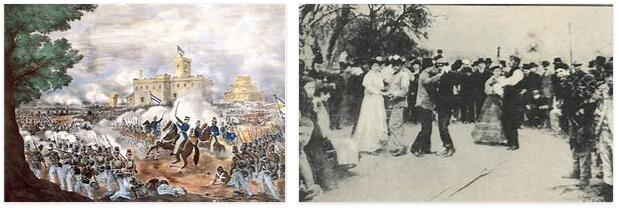The first residents
Between 15,000 and 10,000 BC BC people first settled in what is now Argentina. They came from the north. Some indigenous peoples were still living as hunters and gatherers when the first Europeans entered the country in the 16th century. In the pampas and in northern Patagonia, for example, the Het and in southern Patagonia the Tehuelches lived from hunting and wandered about. In Tierra del Fuego, the Yamaná lived as sea nomads: They moved around in canoes and lived from fishing.
Others, like the Diaguita in the north-west, farmed and lived in one place. They grew corn, beans, pumpkins, and quinoa. They kept the llama as a pet. The Guaraní lived in the northeast. The northwest belonged to the Inca Empire from 1450. Some Indian peoples such as the Kolla adopted the Inca language, Quechua.
Conquest by the Spaniards (16th century)
After Christopher Columbus discovered America, more and more Spaniards and other Europeans came to South America. They conquered the country by force and showed no consideration for the local population. Some peoples opposed the Spaniards until the 19th century, for example the Mapuches in Patagonia. But in the end the white settlers should gain the upper hand.
In 1536 Pedro de Mendoza founded Buenos Aires, today’s capital. However, its settlers had to give up the place again five years later, mainly because the Indians living here resisted submitting themselves to the Spaniards and serving them. In 1580 the city was re-established. In the meantime, other cities had sprung up in the northwest, from Peru.
Spanish colony
In 1542 the Spaniards founded the Viceroyalty of Peru, which initially comprised almost all of South America. Argentina was one of them. The Spanish conquerors forced the Indians to work on their estates. Many Indians died as a result of the cruel treatment by the conquerors or of illness. These had brought in the whites and the Indians had no defenses against the flu or measles.
The Jesuit Reductions (1609-1767)
In 1588 the Jesuits began to evangelize the Indians to Christianity. In 1609 they began to bring the indigenous population together in special settlements. These were called Jesuit reductions. The Jesuits wanted to protect the Indians from the violence of the Spanish conquerors and from slave hunters. On the other hand, their goal was to convert the Indians to the Christian God. This mission was based on the simultaneous recognition of the culture of the Indians.
Many of these settlements arose in an area of the Guaraní that today belongs to the countries of Paraguay, Argentina and Brazil. In what is now Argentina, the area of the Jesuit reductions lies in the northeast. Many Indians sought protection in the reductions. Spaniards were not allowed to enter the reductions.
These village communities were economically very successful, especially in agriculture and handicrafts – far more successful than the Spanish settlements. This led to resentment among the Spaniards. In addition, the attitude of the Jesuits towards the Indians did not correspond to the attitude of the Spanish colonial masters. There were repeated attacks on the reductions. In 1767 the Spanish king finally expelled the Jesuits and dissolved the reductions. The Spaniards hoped for rich income with the confiscated property, but this turned out to be a fallacy. The reductions fell apart.
Part of the Viceroyalty of Río de la Plata (1776-1816)
In 1717, the north of South America had already been split off from the viceroyalty of Peru as the viceroyalty of New Granada in order to better manage the large colony. In 1776 the south was also separated. Argentina no longer belonged to Peru, but with Paraguay, Uruguay and Bolivia to the viceroyalty of Río de la Plata. However, the south of the country remained sparsely populated and was not really under the control of the Spaniards.
Independence (1816)
The struggle for independence began throughout Latin America around 1800. In 1810 a government independent of Spain was formed in Buenos Aires (May Revolution). Argentina finally declared its independence from Spain in 1816, but still under the name United Provinces of the Río de la Plata. Paraguay had already split off in 1811, Bolivia followed in 1825 and Uruguay in 1828. In 1833 Argentina lost the Falkland Islands, which are 400 kilometers off the Argentine coast in the Atlantic, to Great Britain. To get more information on Argentine and South America, check youremailverifier.
The provinces of the Río de la Plata become Argentina (1862)
Until 1853, the provinces of Argentina were largely independent. Only afterwards did they come together to form a republic, which from 1862 was called Argentina. When Paraguay wanted to conquer land in 1864, Argentina, Brazil and Uruguay joined forces in the Triple Alliance War. Paraguay not only lost the war, but also had to surrender areas of its country. Argentina gained land in the north.
The desert campaign began in 1878: the areas in which the Indians had not allowed themselves to be subjugated were conquered militarily, namely in the Chaco, in the Pampas and in Patagonia. Many Indians died in this campaign. Settlers took the land and grew wheat there. It was urgently needed because the population grew rapidly.
Argentina becomes a country of immigration
Few people lived in Argentina. The government sought to bring people into the country in order to take over the sparsely populated areas in the south. The constitution of 1853 offered immigrants good conditions. In the following decades, mainly Italians and Spaniards, but also Germans, French, Poles and other Europeans came in the hope of making their fortune in the distant country.
From 1870 onwards there was an economic boom. Wheat and beef were successfully exported. It was not until the global economic crisis in 1929 that the upswing stopped. In addition, the country had missed industrialization and remained an agricultural country.
